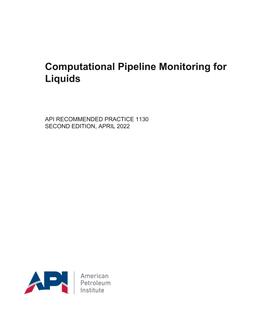This recommended practice (RP) focuses on the design, implementation, testing, and operation of computational pipeline monitoring (CPM) systems that use an algorithmic approach to detect hydraulic anomalies in liquid pipelines. These systems provide tools that assist controllers in detecting commodity releases that are within the sensitivity of an algorithm.
This RP is intended for controllers and operators, CPM system developers and engineers, and others interested in CPM system design, implementation, and operation.
CPM systems provide an alarm and display other related data to the controllers to aid in decision-making. Controllers undertake an immediate investigation, confirm the reason for the alarm, and initiate an operational response to the hydraulic anomaly when the alarm represents an irregular operating condition, abnormal operating condition, or a commodity release.
This RP includes definitions, source and reference documents, concepts of data acquisition, discussion of design and operation of a pipeline as related to CPM, field instrumentation for CPM purposes, alarm credibility, controller response, incident analysis, records retention, maintenance, system testing, training, considerations for setting alarm limits, trending, and recommendations for data presentation. The relationship between the controller and the CPM
system is also discussed.
This RP is written for liquid onshore or offshore trunkline systems. CPM systems have typically been applied to steel pipeline systems. CPM applicability and performance may be limited by the characteristics of non-steel pipelines. This RP was written considering single phase, liquid pipelines. Many of the principles apply to liquid pipelines in intermittent slack line flow or liquid pipelines that may have permanent slack line flow. This RP may not apply to the special case of
determining leaks during shut-in conditions that occur when the line is shutdown (sometimes called static conditions) unless shut- in leak detection is part of the deployed CPM solution.
It is recognized that no single CPM methodology or technology is suitable for all pipelines because each pipeline system is unique in design and operation. This RP complements but does not replace other procedures for monitoring the integrity of the line. CPM systems are one part of an operator’s leak detection program. For further information on leak detection programs, see API RP 1175, Pipeline Leak Detection-Program Management.
This standard supports UN Sustainable Development Goals 9 (Resilient Infrastructure) and 13 (Climate Action).
Product Details
- Edition:
- 2nd
- Published:
- 04/01/2022
- Number of Pages:
- 44
- File Size:
- 1 file , 1.5 MB
- Product Code(s):
- D011032, D011032, D011032
- Note:
- This product is unavailable in Russia, Cuba, Syria, North Korea, Ukraine, Belarus, Iran
